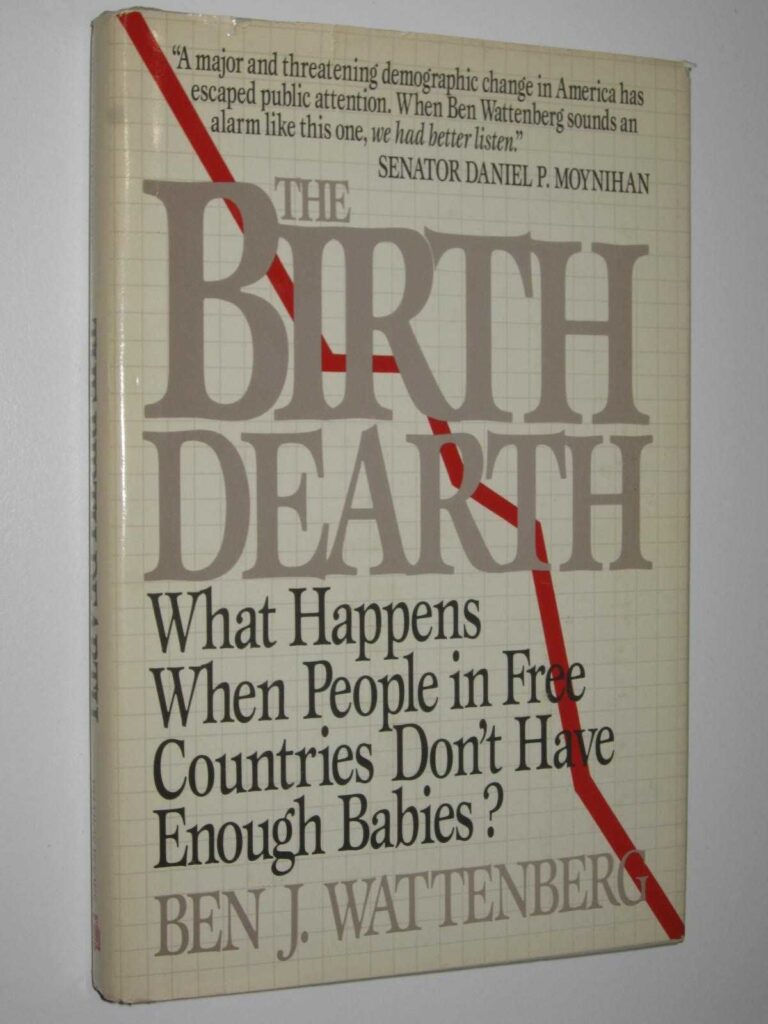Why is the birth dearth book so expensive?
The Birth Dearth book, written by Ben Wattenberg, has long been a controversial and highly sought-after publication due to its high price tag. While some may wonder why the book is so expensive, several reasons contribute to its high cost.
First and foremost, the Birth Dearth book deals with a complex and sensitive subject matter – the declining birth rates in developed countries. Wattenberg tackles this issue with in-depth research and analysis, examining the various factors that contribute to the birth dearth and offering solutions for reversing the trend. The book requires extensive research and analysis, which requires time and resources that are reflected in the book’s price.
Additionally, the Birth Dearth book is published by a well-respected publisher, Basic Books, which is known for producing high-quality, academically rigorous works. The publisher’s reputation and the book’s reputation as a go-to resource on the topic contribute to its high price.
Another factor that contributes to the high cost of the Birth Dearth book is its popularity. As a highly sought-after resource on the topic of declining birth rates, demand for the book is high, leading to a higher price.
Another reason for the book’s high price is its limited availability. The Birth Dearth book is not widely available in bookstores and must be purchased through specialty retailers or online, which can result in higher prices due to the added cost of shipping and handling.
Finally, the Birth Dearth book is a dense and academically rigorous work that is meant for a specific audience – policymakers, academics, and researchers. The book’s target audience is willing to pay a higher price for a resource that will provide them with valuable information and insights on a critical issue.
In conclusion, the Birth Dearth book is expensive due to its complex and sensitive subject matter, reputable publisher, popularity, limited availability, and target audience. While the high price may be off-putting to some, the book is considered a valuable resource on the topic of declining birth rates and is worth the investment for those who are interested in the issue.
Frequently Asked Questions:
What is the birth dearth book about?
The Birth Dearth book is about the declining fertility rates in developed countries and the potential consequences of this trend. It discusses how low birth rates can lead to economic, social, and political challenges, including a shrinking and aging population, a declining labor force, and increased strain on social welfare systems. The book also explores potential solutions to address the birth dearth, such as immigration, family-friendly policies, and encouraging women to have more children.
What is the meaning of birth dearth?
Birth dearth refers to a situation in which there is a significant decrease in the number of births recorded in a particular population or region. It can be caused by a variety of factors, such as economic instability, social changes, or declining fertility rates. Birth dearth can have significant consequences for society, including an aging population and a declining workforce, which can lead to economic and social challenges.
When did birth dearth begin?
Birth dearth, or the decline in fertility rates and birth rates, began in the 1970s and 1980s in developed countries. It has since spread to many developing countries as well.
What is the book flour babies about?
Flour Babies is a novel by Anne Fine about a group of students who are assigned a project in which they must care for a bag of flour as if it were a real baby. The students are given strict instructions on how to care for their “babies,” including feeding, diapering, and handling them. As the project progresses, the students begin to develop a deeper understanding of the responsibilities and challenges of caring for a child. Along the way, they also face personal struggles and challenges that are revealed through their interactions with their “babies.” The novel ultimately explores themes of responsibility, empathy, and the importance of caring for others.
What happens in the book remembrance?
In the book “Remembrance,” a woman named PIpere is struggling to come to terms with the recent death of her husband. She begins to have vivid memories of their life together and the moments they shared, and begins to write them down in a journal. As she reflects on their relationship, she begins to understand and appreciate the depth of their love and the impact he had on her life. Along the way, she also confronts her own grief and learns to find ways to move forward without him. The book explores themes of love, loss, and healing, and ultimately portrays a poignant and uplifting portrayal of the enduring nature of love.
What is the least parented generation?
It is difficult to accurately determine which generation is the least parented, as parenting styles and techniques have varied greatly throughout history and can differ greatly within a single generation. Additionally, the definition of “parenting” can vary from person to person and may include not only biological parents but also caregivers and other influential figures in a child’s life.
That being said, some may argue that the current generation of young adults, often referred to as “Generation Z,” may be considered the least parented due to the prevalence of technology and social media in their upbringing. This generation has grown up with constant access to screens and may have had less face-to-face interaction and guidance from their parents compared to previous generations. However, this is a subjective assessment and cannot be definitively proven.
How many generations passed 100 years?
It is impossible to determine the number of generations that passed in 100 years without more information. The number of generations that pass within a given time frame depends on the length of the generation span and the rate of reproduction within the population.
What is the 70-year-old generation called?
The 70-year-old generation is typically referred to as the “Baby Boomers,” as they were born during the post-World War II baby boom between 1946 and 1964.
What word is the opposite of dearth?
Plenty.
What are the implications of the birth dearth?
The birth dearth, or declining birth rates, has several potential implications:
- Aging population: With fewer babies being born, the overall population may start to age and there may be a larger proportion of elderly people relative to the working-age population. This could lead to issues with social security, pension, and healthcare systems.
- Labor shortages: With fewer young people entering the workforce, there may be a shortage of workers in certain industries, leading to higher wages and competition for jobs.
- Economic impact: A declining birth rate may lead to slower economic growth, as there are fewer consumers and potential workers.
- Changes in family dynamics: With fewer children, families may be smaller and there may be less pressure on parents to have children to help care for them in old age.
- Changes in social structures: A declining birth rate may lead to changes in social structures, such as an increase in single-person households or an increase in intergenerational living.
- Changes in immigration policies: Some countries may need to rely more on immigration to fill labor shortages, which could lead to changes in immigration policies and tensions over cultural assimilation.
What is the dearth of money?
The dearth of money refers to a shortage or deficiency of money in an economy or financial system. It can lead to a reduction in economic activity, as individuals and businesses are unable to access the funds needed to invest, purchase goods and services, or pay for necessary expenses. A dearth of money can also cause an increase in prices, as individuals and businesses are willing to pay more for goods and services due to the limited availability of money. This can lead to inflation and economic instability.
What is the lucky generation?
It is difficult to determine which generation is considered the “lucky generation” as it can vary depending on personal perspective and individual circumstances. Some may consider the Baby Boomers (born between 1946 and 1964) to be the lucky generation due to the economic prosperity and job opportunities that were available during their time. Others may consider the Millennial generation (born between 1981 and 1996) to be the lucky generation due to the advancements in technology and the accessibility of information. Ultimately, it is subjective and can vary from person to person.
What is the oldest Generation Alpha?
The oldest Generation Alpha currently is about 10 years old, as the generation is defined as those born from 2010 to 2025.
What is birth minus death?
Birth minus death is the difference between the number of births and the number of deaths in a population. It is a measure of population growth or decline.
What was the birth rate in medieval times?
It is difficult to accurately determine the birth rate in medieval times as there were many variables that could have influenced it, such as the availability of food, the prevalence of disease, and the social and economic status of individuals. However, it is generally believed that the birth rate in medieval times was relatively high, with families having an average of 5-7 children. This was likely due to the high infant mortality rate and the importance of having children to help with farming and other household tasks.
What age is flour babies for?
Flour babies are typically used as a teaching tool in high school or college classrooms to simulate the responsibilities of caring for a newborn baby. They are not recommended for use with children under the age of 14 due to the level of responsibility and care required for the project.
What age is the book Dustbin baby for?
The book Dustbin Baby is appropriate for readers ages 12 and up. It deals with themes of abandonment, foster care, and identity, and may be too mature for younger readers.
Why are there black-and-white baby books?
There are black-and-white baby books for a few reasons:
- Visual Development: Studies have shown that black-and-white images are easier for babies to process and focus on, as their visual development is not fully developed at a young age. Black-and-white books can help stimulate the brain and improve visual perception.
- Contrast: The high contrast of black and white can help babies distinguish between different shapes and patterns, which can aid in their cognitive development.
- Simplicity: Black-and-white books are simpler and less overwhelming for babies, as they do not have to process complex colors and patterns. This can help babies focus on the story and illustrations.
- Cost: Black-and-white books are often cheaper to produce, as they do not require the use of multiple colors in the printing process.
How many Books of Remembrance are there?
There are eight Books of Remembrance in total.













